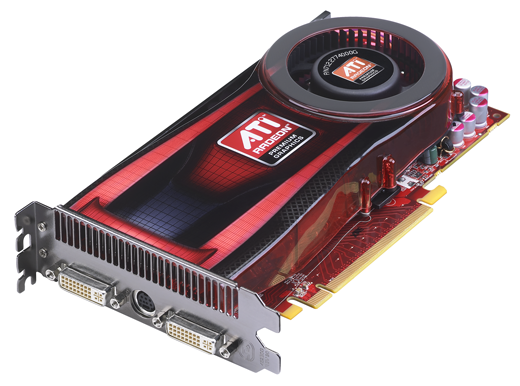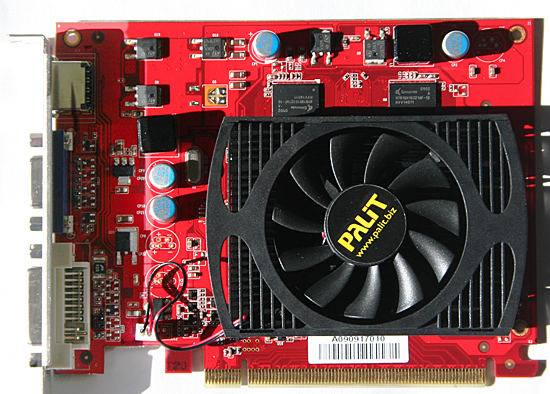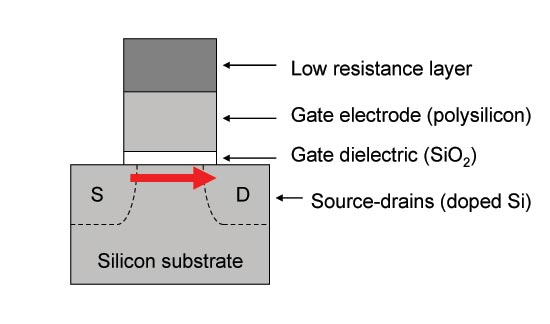The RV870 Story: AMD Showing up to the Fight
by Anand Lal Shimpi on February 14, 2010 12:00 AM EST- Posted in
- GPUs
The Payoff: How RV740 Saved Cypress
For its first 40nm GPU, ATI chose the biggest die that made sense in its roadmap. That was the RV740 (Radeon HD 4770):

The first to 40nm - The ATI Radeon HD 4770, April 2009
NVIDIA however picked a smaller die. While the RV740 was a 137mm2 GPU, NVIDIA’s first 40nm parts were the G210 and GT220 which measured 57mm2 and 100mm2. The G210 and GT220 were OEM-only for the first months of their life, and I’m guessing the G210 made up a good percentage of those orders. Note that it wasn’t until the release of the GeForce GT 240 that NVIDIA made a 40nm die equal in size to the RV740. The GT 240 came out in November 2009, while the Radeon HD 4770 (RV740) debuted in April 2009 - 7 months earlier.

NVIDIA's first 40nm GPUs shipped in July 2009
When it came time for both ATI and NVIDIA to move their high performance GPUs to 40nm, ATI had more experience and exposure to the big die problems with TSMC’s process.
David Wang, ATI’s VP of Graphics Engineering at the time, had concerns about TSMC’s 40nm process that he voiced to Carrell early on in the RV740 design process. David was worried that the metal handling in the fabrication process might lead to via quality issues. Vias are tiny connections between the different metal layers on a chip, and the thinking was that the via failure rate at 40nm was high enough to impact the yield of the process. Even if the vias wouldn’t fail completely, the quality of the via would degrade the signal going through the via.
The second cause for concern with TSMC’s 40nm process was about variation in transistor dimensions. There are thousands of dimensions in semiconductor design that you have to worry about. And as with any sort of manufacturing, there’s variance in many if not all of those dimensions from chip to chip. David was particularly worried about manufacturing variation in transistor channel length. He was worried that the tolerances ATI were given might not be met.

A standard CMOS transistor. Its dimensions are usually known to fairly tight tolerances.
TSMC led ATI to believe that the variation in channel length was going to be relatively small. Carrell and crew were nervous, but there’s nothing that could be done.
The problem with vias was easy (but costly) to get around. David Wang decided to double up on vias with the RV740. At any point in the design where there was a via that connected two metal layers, the RV740 called for two. It made the chip bigger, but it’s better than having chips that wouldn’t work. The issue of channel length variation however, had no immediate solution - it was a worry of theirs, but perhaps an irrational fear.
TSMC went off to fab the initial RV740s. When the chips came back, they were running hotter than ATI expected them to run. They were also leaking more current than ATI expected.
Engineering went to work, tearing the chips apart, looking at them one by one. It didn’t take long to figure out that transistor channel length varied much more than the initial tolerance specs. If you get a certain degree of channel length variance some parts will run slower than expected, while others would leak tons of current.
Engineering eventually figured a way to fix most of the leakage problem through some changes to the RV740 design. The performance was still a problem and the RV740 was mostly lost as a product because of the length of time it took to fix all of this stuff. But it served a much larger role within ATI. It was the pipe cleaner product that paved the way for Cypress and the rest of the Evergreen line.
As for how all of this applies to NVIDIA, it’s impossible to say for sure. But the rumors all seem to support that NVIDIA simply didn’t have the 40nm experience that ATI did. Last December NVIDIA spoke out against TSMC and called for nearly zero via defects.
The rumors surrounding Fermi also point at the same problems ATI encountered with the RV740. Low yields, the chips run hotter than expected, and the clock speeds are lower than their original targets. Granted we haven’t seen any GF100s ship yet, so we don’t know any of it for sure.
When I asked why it was so late with Fermi/GF100, NVIDIA pointed to parts of the architecture - not manufacturing. Of course, I was talking to an architect at the time. If Fermi/GF100 was indeed NVIDIA’s learning experience for TSMC’s 40nm I’d expect that its successor would go much smoother.
It’s not that TSMC doesn’t know how to run a foundry, but perhaps the company made a bigger jump than it should have with the move to 40nm:
| Process | 150nm | 130nm | 110nm | 90nm | 80nm | 65nm | 55nm | 40nm |
| Linear Scaling | - | 0.866 | 0.846 | 0.818 | 0.888 | 0.812 | 0.846 | 0.727 |
You’ll remember that during the Cypress discussion, Carrell was convinced that TSMC’s 40nm process wouldn’t be as cheap as it was being positioned as. Yet very few others, whether at ATI or NVIDIA, seemed to believe the same. I asked Carrell why that was, why he was able to know what many others didn’t.
Carrell chalked it up to experience and recounted a bunch of stuff that I can’t publish here. Needless to say, he was more skeptical of TSMC’s ability to deliver what it was promising at 40nm. And it never hurts to have a pragmatic skeptic on board.










132 Comments
View All Comments
n7 - Sunday, February 14, 2010 - link
Another great story told.Thanx, Anand.
MrK6 - Sunday, February 14, 2010 - link
What a great piece. Thank you for taking the time to put this together; it's one of the best tech articles I've read.archcommus - Sunday, February 14, 2010 - link
Haven't even read the whole thing yet but I can already say this is excellent. Thank you, Anand.indicator - Sunday, February 14, 2010 - link
Hi allI felt I had to register here after reading this article , what a fantastic insight into everything that goes into making these GPU's and the dedication and talent it takes to be so creative.
Great to see Anands enthusiasm for the industry come across in the article too
I've been coming here and reading Anandtech since around the mid ninties I guess , it is a superb source of information , I look forward to every new article/review posted.
Keep it up guys
Lee
(uk)
d3x7r0 - Sunday, February 14, 2010 - link
Very very good article as usual in this website. AnandTech has been one of my favourite sites in the area for so long I don't even remember how I found out about the website, I actually believe I was still in 56k when I first came here.Anyway reading this article made me speculate on something (and please correct me if I'm wrong): If I got the timings right AMD-ATI should be working on the Northern Islands since the Radeon HD4xxx series days so the same issues they had with the HD5xxx series would be in the past. If this is true it means they know the HD4xxx were a success from the beginning of the process (or near it) and as such I can't but help it be even more excited to see what the next generation of ATI cards has in store.
It's such a good time to be an ATI fan it's not even funny :D
Atlantis6000bc - Sunday, February 14, 2010 - link
Those kind of article are the prime reason why I keep coming back to Anand....keep 'em comingThe13thWizard - Sunday, February 14, 2010 - link
Thanks Anand! Thats the best IT article Ive ever read! Very toughtfull and interesting!arnavvdesai - Sunday, February 14, 2010 - link
Really helps understand the industry a lot more. I really wish AMD would take a cue from its graphics division and really start hammering out what kind of chips do they want to build. However, they have their own set of challenges as Intel unlike NVIDIA is really really good on the foundry side as well.However, with gaming becoming more and more centered on consoles, does ATi have something cooking for the next generation of consoles? Would love Anand to ask them something about that. Do they believe that they will continue to sell enough cards to continue recouping their costs of designing and manufacturing them.
Vishnu Narayanan S - Sunday, February 14, 2010 - link
First of all, hats off to you for this amazing article.... Its these articles that bind us to the Anandtech website for years and years.I sincerely hope and request you to provide similar in-depth and "behind the scenes" stories from NVIDIA and Intel. Just to satisfy the FANbois... lol
fausto412 - Sunday, February 14, 2010 - link
once i started reading i couldn't stop. for a geek like me this was almost like sex:) keep them coming!